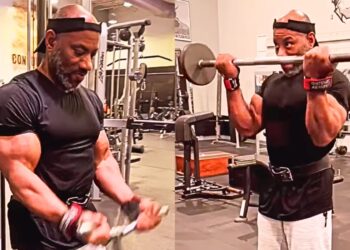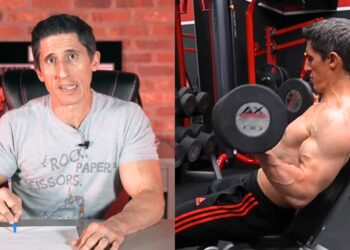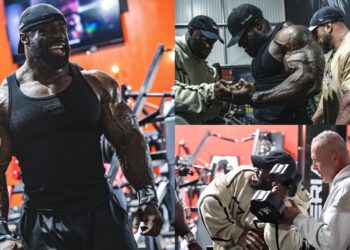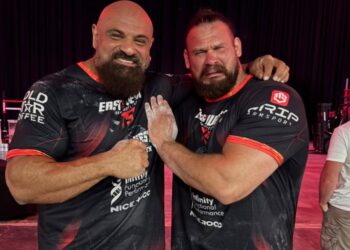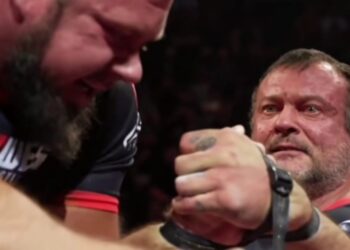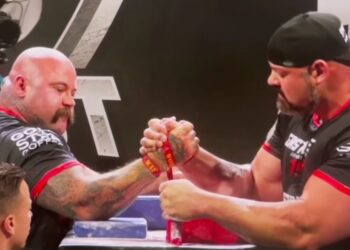Arm wrestling is one of the ultimate tests of strength. Unlike powerlifting or weightlifting, arm wrestling pits one person directly against another to determine who is the strongest. In many ways, arm wrestling is a martial art, but without all the kicking and punching!
However, make no mistake: arm wrestling is a very technical activity, and skill is as important as strength.
Arm wrestling has been around for centuries and probably originated in ancient Egypt and Greece. It’s now practiced all over the world and is especially popular in America and Europe.
What was originally an informal activity is now a popular amateur and professional sport with several governing bodies, including:
- The World Armwrestling Federation (WAF)
- The International Armwrestling Federation (IAF)
- World Wristwrestling Championship (WWC)
Despite being a legitimate sport, many people still enjoy casual arm wrestling and like to test their strength against friends and acquaintances. But if you really want to dominate at arm wrestling, you need to train for it.
Not only will this improve your chances of winning, but also reduce your risk of injury. Arm wrestling injuries are pretty common, and humeral spiral fractures can be particularly serious (1).
Level Up Your Fitness: Join our 💪 strong community in Fitness Volt Newsletter. Get daily inspiration, expert-backed workouts, nutrition tips, the latest in strength sports, and the support you need to reach your goals. Subscribe for free!
In this article, we reveal some of the best arm-wrestling exercises and provide you with a couple of workouts to try.
The Best Arm-Wrestling Exercises
As you’d expect, building strength for arm wrestling revolves around training your arms, forearms, and shoulders (2). However, it’s important to note that arm wrestling is a full-body activity, and your legs and core are as important as your upper body.
With that in mind, make sure you combine the following exercises with a well-rounded general strength training program.
1. Cable Internal Rotation
Target muscles: Rotator cuff, anterior deltoid.
The rotator cuff is a group of four small muscles deep in your shoulder. Responsible for shoulder joint stability and control, these muscles take a hammering during arm wrestling. Strengthening your rotator cuff will help make you a better arm wrestler while reducing your risk of injury.
Steps:
- Adjust the pulley on a cable machine to around waist height.
- Stand side-on to a cable machine and hold the handle in your nearside hand.
- Bend your elbow to 90 degrees and tuck your upper arm into your side.
- Keeping your elbow bent and against your body, rotate your arm inward and across your body.
- Turn your arm outward as far as comfortable and repeat.
- Switch sides and do the same number of reps with the opposite arm.
Tips:
- Hold a folded towel between your upper arm and ribs to prevent cheating.
- You can also do this exercise with a resistance band.
- Flex your wrist in a cupping motion to make this exercise more specific to arm wrestling.
2. Cable External Rotation
Target muscles: Rotator cuff, posterior deltoid.
While arm wrestling involves mostly internal or medial shoulder rotation, you must also train your external rotators to keep your shoulders stable and healthy. Therefore, for every set you do of exercise #1, make sure you also do a set of this exercise. Weak external rotators increase your risk of suffering an arm-wrestling injury.
Steps:
- Adjust the pulley on a cable machine to around waist height.
- Stand side-on to a cable machine and hold the handle in your furthest hand.
- Bend your elbow to 90 degrees and tuck your upper arm into your side.
- Keeping your elbow bent and against your ribs, rotate your arm outward and away from your body.
- Return to the starting position and repeat.
Tips:
- Hold a folded towel between your upper arm and ribs to prevent cheating.
- You can also do this exercise with a resistance band.
- Extend your wrist backward to increase forearm extensor activation, making this exercise more arm wrestling-specific.
3. Rocking Hammer Curls
Target muscles: Biceps, forearms.
The biceps play a critical role in arm wrestling (2). You use your biceps to keep your and your opponent’s hands close to your chest, which is a mechanically advantageous position. Remember, though, they’ll be trying to do the same to you! This exercise is one of the best ways to train for this aspect of arm wrestling.
Steps:
- Holding a heavy dumbbell, rest your upper arm on the top of a preacher bench, palm facing inward, i.e., a neutral or hammer grip.
- Position the dumbbell a few inches from your shoulder.
- Keeping your elbow angle constant, rock your body forward to transfer the weight onto your biceps. Do not let your arm straighten.
- Rock back to the starting position and repeat.
Tips:
- Use a thick-handled dumbbell to develop your grip as well as your biceps.
- Remember to train both arms equally.
- You can also do this exercise with a conventional underhand grip.
4. Cable Cupping
Target muscles: Forearms, biceps, lats.
Cable cupping targets your forearm flexors. These muscles are critical in arm wrestling as you use them to bend your opponent’s wrist back so you can pin them for the win. You also need to be strong enough to stop them from doing this to you! Legendary champ Devan Larratt lists cupping as one of the most crucial arm wrestling exercises.
Steps:
- Attach a thick-handled D-shaped bar to a cable machine set to about shoulder height.
- Grip the handle with a thumbless/false grip.
- Bend your elbow to about 90 degrees and flex your biceps.
- Bend your wrist and try to touch your forearm with the handle.
- Next, pull the handle toward your chest.
- Return to the starting position and repeat.
- Do the same number of reps on the opposite hand.
https://www.youtube.com/watch?v=NmR_cPo4JvA?feature=share
Level Up Your Fitness: Join our 💪 strong community in Fitness Volt Newsletter. Get daily inspiration, expert-backed workouts, nutrition tips, the latest in strength sports, and the support you need to reach your goals. Subscribe for free!
Tips:
- No thick-handled D-bar at your gym? Buy some clip-on thick grip grips or wrap the handle in a towel to increase its diameter.
- Keep the range of motion short to replicate the demands of arm wrestling. Don’t turn this exercise into a standing cable row.
- You can also do this exercise with a resistance band.
5. Sledgehammer Pronation/Supination
Target muscles: Forearms.
Some arm-wrestling strategies involve twisting your opponent’s wrist to force them into a weaker position. They’ll also be trying to do the same to you. This unique exercise targets your forearm pronator and supinator muscles to increase your rotational strength.
- Hold a sledgehammer with a single-handed neutral grip. Bend your elbow to 90 degrees, keeping your upper arm close to your side.
- Slowly rotate the sledgehammer clockwise and then counterclockwise while keeping your arm bent.
- Continue for the desired number of reps.
Tips:
- The further down the handle you hold your sledgehammer, the harder this exercise becomes. Alter your grip accordingly.
- You can also do this exercise with an adjustable dumbbell with a weight at one end.
- Try tilting the sledgehammer forward and back to target your forearm flexors.
6. Towel Grip Pull-Ups
Target muscles: Lats, biceps, forearms.
This challenging pull-up variation is a real all-in-one arm-wrestling exercise, targeting several of your most important muscles. As such, it’s an ideal option for time-pressed exercisers who don’t have time for longer, more complex workouts.
Steps:
- Hang a towel over the middle of your pull-up bar.
- Take one end in each hand and grip it tightly.
- Bend your arms and pull your shoulders to your hands.
- Extend your arms and repeat.
Tips:
- The thicker the towel, the harder it will be to grip and the more demanding the exercise becomes.
- You can also use two towels instead of one.
- Do towel grip dead hangs if you are unable to do pull-ups.
7. Kettlebell Hammer Curls
Target muscles: Biceps, forearms.
Dumbbell hammer curls are an excellent exercise for arm wrestlers, but they’re even better when you use kettlebells. Using KBs instead of dumbbells emphasizes your grip as well as working your biceps and forearms. You’ll have to crush the handles to keep those weights stable.
Steps:
- Hold a kettlebell in each hand, arms by your sides. Turn your palms in to face your legs, i.e., a neutral grip.
- Keeping your upper arms close to your sides, bend your elbows and raise the weights until your forearms are roughly parallel to the floor.
- Lower the kettlebells and repeat.
- Squeeze the kettlebell handles tightly throughout.
Tips:
- Use an alternating arm action if preferred.
- You can also do this exercise using one arm at a time.
- Try single-arm kettlebell preacher curls for variety.
8. Barbell Wrist Curls/Reverse Wrist Curls
Target muscles: Biceps, forearms.
This exercise combo works forearm flexors and extensors, making it a very time-efficient way to build your lower arms and grip. Simply do regular wrist curls followed by a set of reverse wrist curls to pump up your forearms in double-quick time.
Steps:
- Sit on a bench and hold a barbell with a narrow, underhand grip. Rest your wrists on the edge of the bench.
- Extend your wrists and lower the bar toward the floor.
- Curl the weight back up and complete the desired number of reps.
- Without resting, turn your hands over and place your forearms on the edge of the bench.
- Bend your wrists and lower the bar down toward the floor.
- Flex your wrists and curl the weight back up.
- Continue for the desired number of reps.
Tips:
- You can also do this exercise with dumbbells.
- Use a cable machine for variety.
- A thick bar makes this exercise even more challenging.
Related: The 10 Best Forearm Exercises for Arm Wrestling
Armwrestling Workouts
While any of these exercises will improve your strength for arm wrestling, you’ll get better results if you follow a more prescriptive training program. So, alternate between these two workouts, e.g., #1 on Monday and #2 on Friday, and you’ll soon be unbeatable at the arm-wrestling table.
Arm Wrestling Workout #1
| Exercise | Sets | Reps | Recovery | |
| 1 | Rocking hammer curls | 4-5 | 6-8 | 2 minutes |
| 2 | Cable cupping | 4-5 | 8-10 | 90 seconds |
| 3 | Cable external rotation | 3-4 | 12-15 | 60 seconds |
| 4 | Sledgehammer pronation/supination | 2-3 | 15-20 | 60 seconds |
Arm Wrestling Workout #2
| Exercise | Sets | Reps | Recovery | |
| 1 | Towel grip pull-ups | 4-5 | 6-8 | 2 minutes |
| 2 | Kettlebell hammer curls | 4-5 | 8-10 | 90 seconds |
| 3 | Cable internal rotation | 3-4 | 12-15 | 60 seconds |
| 4 | Barbell wrist curls/reverse wrist curls | 2-3 | 15-20 | 60 seconds |
Related: How to Warm Up for Strength Training
Closing Thoughts
General strength training will do a lot of your arm-wrestling performance. Exercises like deadlifts, squats, bench presses, and curls will make you a formidable arm-wrestling opponent.
But, if you want to take on all comers and battle with the best, you’ll undoubtedly benefit from adding some specific arm-wrestling exercises to your workouts.
The eight exercises in this article target the most important muscles for arm wrestling. However, you also need to develop your technique, so practice arm wrestling against live opponents whenever you can.
Finally, don’t ignore the nagging shoulder, elbow, or wrist pain that often comes with arm wrestling. A lot of top arm wrestlers end up needing surgery to fix their chronic aches and pains. A few days or weeks of rest now is always preferable to a long, enforced rest in the future.
Related: Armwrestling Champions: Their Legacies and Signature Techniques
References:
- Moloney DP, Feeley I, Hughes AJ, Merghani K, Sheehan E, Kennedy M. Injuries associated with arm wrestling: A narrative review. J Clin Orthop Trauma. 2021 Apr 20;18:30-37. doi: 10.1016/j.jcot.2021.04.010. Erratum in: J Clin Orthop Trauma. 2021 Jul 30;20:101539. PMID: 33996446; PMCID: PMC8091050.
- Silva DC, Silva Z, Sousa Gda C, Silva LF, Marques Kdo V, Soares AB, Cerqueira EP, Liberti EA, Bérzin F. Electromyographic evaluation of upper limb muscles involved in armwrestling sports simulation during dynamic and static conditions. J Electromyogr Kinesiol. 2009 Dec;19(6):e448-57. doi: 10.1016/j.jelekin.2008.09.014. Epub 2008 Dec 16. PMID: 19091596.


